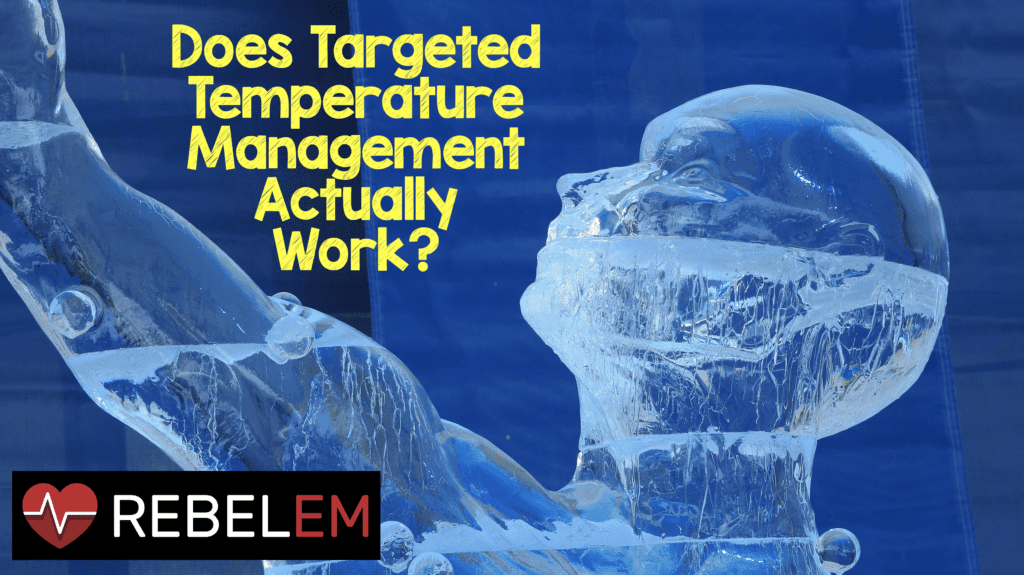
What Article are we Reviewing:
Schenone et al. Therapeutic Hypothermia After Cardiac Arrest: A Systematic Review/Meta-Analysis Exploring the Impact of Expanded Criteria and Targeted Temperature. Resuscitation 2016; 108: 102 – 110. PMID: 27521472
What they did:
- Updated meta-analysis to assess performance of TH after out of hospital cardiac arrest (OHCA) on mortality and neurologic outcome at hospital discharge when treating patients within and beyond the initial criteria of the landmark trials.
- Systematic review and pooled analysis to determine the impact of different temperature goals on discharge outcomes.
Outcomes:
- Hospital mortality and neurological outcome at discharge based on Cerebral Performance Category (CPC) of 1 – 2
Inclusion criteria:
- Studies with patients age 15 years and older remaining comatose after OHCA with any initial rhythm.
- No restrictions on downtime, bystander resuscitation, witnessed arrest, or persistent shock.
- Studies had to report the achieved cooling temperature.
- Only studies comparing hypothermia to normothermia were considered for meta-analysis.
- RCTs and Observational trials with ≥ 10 patients
Results:
- 32,275 Citations
- 149 articles for detailed evaluation
- 24 articles included
- 11 studies included in the meta-analysis (3 RCTs, 8 observational cohort studies)
- 1381 patients
- 51.6% had a shockable rhythm
- Most did not receive bystander CPR
- Mean control temperature was 37°C (Range: 36.1 – 37.5)
- Mean Arrest Downtimes 24.6 min (Range 20 – 34.6 min)
- Risks of bias
- Only 2 trials performed proper randomization, while one performed a quasi-randomized study.
- 2 of the 3 RCTs blinded the assessors to outcomes.
- Use of TH after OHCA decreased mortality (OR 0.51 [95% CI 0.41-0.64])
- Use of TH improved odds of survival with good neurologic outcome (OR 2.48 [95% CI 1.91-3.22])
- There was no difference in mortality (p=0.86) or neurologic outcomes (p=0.32) across temperatures ranging from 32°C to 36°C.
- Initial rhythm (p=0.01) and downtime (p=0.014) were independently associated with neurologic outcomes
Strengths:
- Meta-analysis was performed using the Preferred Reporting Items of Systematic Reviews and Meta-Analysis (PRISMA) for RCTs and Meta-analysis of Observational Studies in Epidemiology (MOOSE) for Observational trials guidelines
- Used PICOS (Participants, Intervention, Comparison, Outcomes, and Study Design) model to generate research questions
- Cochrane Collaboration tool was used to assess risk of bias of RCTs and Newcastle-Ottawa assessment tool was used for cohort studies
Limitations:
- Use of observational cohort studies adds a potential risk of bias
- Restricted enrollment to those reporting achieved temperatures during cooling creates a possible selection bias
- Excluded abstracts or unpublished research adds an additional publication bias
Discussion:
- This analysis did not show the superiority of one temperature level over another during TH. Of note the majority of the studies in this analysis used a target temperature of 33 – 34 degrees Celsius. Therefore the number of studies cooling at temperatures other than 33 degrees Celsius or 34 degrees Celsius were small. This decreases the power to detect differences when using more extreme temperatures
- There was a non-significant trend toward improved outcomes at lower target temperatures in non-shockable rhythms. The reason for this was not elucidated in this study.
Authors’ conclusions:
- “Our analysis proves there is a benefit of TH in a much broader spectrum of patients [from the original 2002 trials], and perhaps clinical guidelines need to strongly favor TH in all patients with cardiac arrest.”
- “At this time there is no evidence to support the use of one temperature level over others across the entire range of included temperatures of 32°C and 36°C during TH after OHCA.”
Take home points:
- Current evidence does support the use of targeted temperature management in ROSC patients after cardiac arrest
- The current optimal temperature remains elusive, but what is certain is that the prevention of fever is paramount.
For More on This Topic Checkout:
- Scott Weingart at EMCrit: EMCrit Wee – The Targeted Temperature Trial Changes Everything
- Scott Weingart at EMCrit: Five Minutes with Jon Rittenberger on the TTM Trial
- Simon Carley at St. Emlyn’s: JC – What’s the Target Temperature for OOHCA Cooling
References:
- Bernard SA et al. Treatment of comatose survivors of out-of-hospital cardiac arrest with induced hypothermia. N Engl J Med. 2002 Feb 21; 346(8): 557-63. PMID: 11856794
- HACA Study Group. Mild therapeutic hypothermia to improve the neurologic outcome after cardiac arrest. N Engl J Med. 2002 Feb 21; 346(8): 549-56. PMID: 11856793
- Callaway CW et al. Part 8: post-cardiac arrest care: 2015 American Heart Association Guidelines Update for Cardiopulmonary Resuscitation and Emergency Cardiovascular Care. Circulation. 2015; 132(suppl 2): S465-S482. PMID: 26472996
Post Peer Reviewed By: Salim R. Rezaie (Twitter: @srrezaie)



